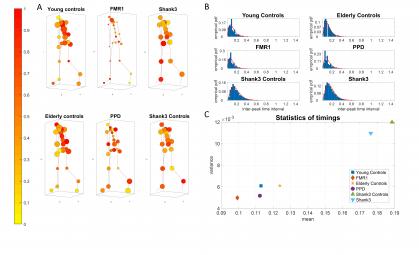Rutgers Researchers Find Links to Genetic Disorders in Walking Patterns

Rutgers researchers have linked the genetic disorders Fragile X and SHANK3 deletion syndrome – both linked to autism and health problems – to walking patterns by examining the microscopic movements of those wearing motion-sensored sneakers.
The method, published in a new study in the journal Nature Scientific Reports, detects gait problems 15 to 20 years before their clinical diagnosis and could help advance intervention models to preserve brain structure and function.
“Walking patterns can be a revealing trait of health, but gait symptoms of disorders like Fragile X can escape the naked eye for years until they are visibly noticeable,” said study coauthor Elizabeth Torres, a professor of psychology at Rutgers University-New Brunswick and director of the Sensory Motor Integration Lab. “Given issues with anatomical differences—such as people with longer or shorter limbs—and disease complexity, it has remained challenging to use walking patterns to screen nervous system disorders more broadly, across disorders impacting people of different ages and developmental stages.”
According to the National Fragile X Foundation, approximately 1 in 468 men and 1 in 151 women are carriers of the abnormal gene that causes Fragile X syndrome. The National Organization for Rare Disorders notes over 30 percent of people with SHANK3 deletion typically require two or more chromosome studies before the deletion is detected. As such, the estimated prevalence is 2.5-10 per million births with equal likelihood of males and females being affected.
In the study, researchers examined the walking movements that cannot be seen by the naked eye in 189 people to detect nervous system disorders.
The microscopic movements are detectable using statistical techniques developed by Torres and causal forecasting methods developed by Rutgers graduate student Theodoros Bermperidis, alongside wearable motion-sensored sneakers created by Stevens Institute of Technology collaborators.
The researchers combined gait data from various patients and those without any disorders using video, heart rates and wearable technology like a Fitbit. Participants completed a simple walking task while wearing the smart shoes that collected an assortment of signals across the body and feet.

Torres and her team analyzed how the spikes derived from microvariations in the movements’ stream, changed from moment to moment and at what rate. Instead of taking grand averages that discard these spikes as noise, they examined peaks, valleys and neighboring points surrounding the peaks, and causally determined important lags in the spikes’ timing.
The study provides a framework to help predict the early departure of normal walking patterns in healthy young people, both for normal aging and for participants who are Fragile X carriers. The methods help stratify a random draw of the population with autism-related disorders.
“Given that Fragile X and SHANK3-related syndromes remain high in other neurological conditions such as autism, Fragile X-associated tremor/ataxia syndrome and Parkinson’s, this is an important way to detect signs of abnormal patterns,” said lead author Bermperidis.
According to the research, gait declines naturally with typical aging. However, the hip, knee and ankle joints and the thigh, leg and foot bones are the first limbs impacted by aging.
Doctors face the challenge of diagnosing a patient that comes to their office for the first time showing unusual gait patterns. Torres says biosensors paired with analytics and the doctor’s broad experience can altogether offer much more than meets the eye.
Study co-authors included Richa Rai, a graduate student at Rutgers, Jihye Ryu, a former Rutgers student and researchers from Stevens Institute of Technology, Columbia University, Columbia University Medical Center, New York Presbyterian-Columbia University Irving Medical Center and Columbia University College of Physicians and Surgeons.
The research was funded by the New Jersey Governor’s Council for the Medical Research and Treatments of Autism and by the Nancy Lurie Marks Family Foundation Career Development Award to EBT.



